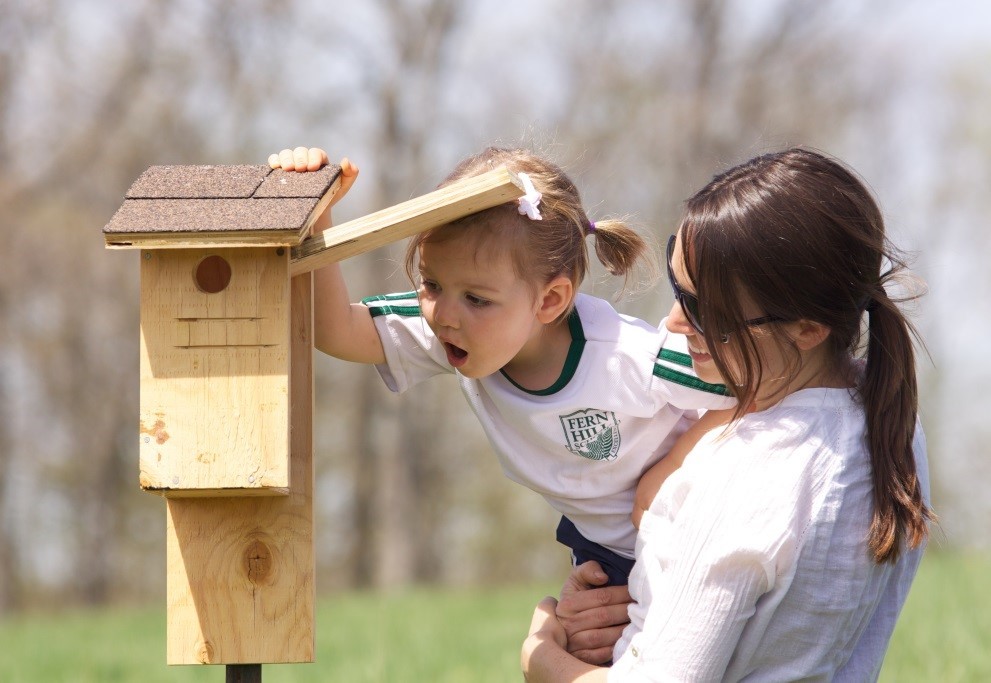Fern Hill School’s Field Studies Programme
Posted: 18 September 2019

IDEALS
- Environmentalism
- Service
Discoveries
- Inquisitiveness
- Problem solving
- Sense of responsibility
- Commitment to sustainability
- Compassion
- Teamwork
Age range
Whole school
Curriculum Area
Outdoor learning
Overview
Fern Hill School’s Burlington Campus sits on 30 acres of green space, including forest, stream, marsh and meadow. Inspired by this diverse habitat, our Field Studies Programme has been designed to connect students to their natural world. We have recently built a bird banding field station to allow for the care of all living things on our campus grounds. Students, as young as four years old, catch and release migrating birds, tag and record scientific information that is used by scientists in data banks across the continent.
Our Outdoor Learning Programme is designed to connect children to the natural world. Our goal is to foster a love of nature and stewardship of the environment. Children engage in citizen science projects such as supporting the at-risk Eastern Bluebirds with nesting boxes and habitat restoration; creating pollinator packets that introduce seeds from native plants, and the program is less classroom science and more experiential.
Planning
Fern Hill had the benefit of a beautiful piece of land, but the program was really the result of several teachers who had a passion for the natural world and who saw an opportunity to share it with our students. They developed the curriculum to support weekly classes throughout all grades and the administration provided the infrastructure to support the curriculum as it grew. A bridge was built over our stream, a nature trail was mulched and an outdoor classroom with benches was built and our greens-keepers were asked to let many areas go to seed and grow wild. It was amazing how little needed to be done to provide an experience where children felt immersed in nature. Once we had the curriculum and initial construction done, we had an official opening of the program that was shared with our families.
Since its introduction, we have constructed our Field Station where children meet for classes and houses our bird banding station. Our Young Ornithologists meet before school to band birds and record the data into an international database. They are often rewarded by catching a bird wearing a Fern Hill band that was applied as many as 5 years ago – such is the tight route of the migration patterns.
Activity
Our Field Studies Programme allows students from all grades to engage with nature throughout the seasons, as part of the weekly curriculum. These interactions become the staging ground for developing keen observation skills, curiosity, independence and a compassionate connection to the natural world. We are very excited that our Field Studies Programme is connecting the next generation of conservationists, including inquisitive scientists, creative artists, social entrepreneurs and ingenious engineers, to connect with nature in rich, meaningful and transformative ways.
Beginning with Preschool students, the Primary Programme focuses on nurturing an innate sense of wonder and inquisitiveness by integrating nature into daily activities. Through play, exploration and close investigation, students are empowered to learn new skills, build confidence and develop a passion for understanding nature’s patterns, ecological communities and plant and animal species.
Older students develop their field skills by participating in a variety of on-site monitoring and restoration projects including bird banding, engineering habitat, monitoring of Eastern Bluebird nesting boxes, creation of a Monarch butterfly way station and stewardship of our native species garden. In addition, Citizen Science projects including Fall and Winter bird counts, marsh monitoring, invertebrate counts and reptile inventories are part of this exciting programme. This engaging and relevant programming fosters in children a passion for the natural world, which in turn encourages enthusiasm for the academic component of the program, designed to develop problem solving, ingenuity and critical thinking.
Winter in Canada cloaks our school in snow and cold temperatures for a chunk of the school year. Students still venture out each week to explore, sometimes wearing our class sets of snow shoes so they can follow animal tracks in the snow. Constructing Quinzees (small igloos) is an annual event that lingers for several days until we get a warm spell when they softening snow indicates it’s time for senior students to enjoy the task of knocking them down.
The butterfly meadow project focused on providing habitat for a number of species along with the Mottled Duskywing that is at risk in our area. Students planted native species of plants in various locations around the school to encourage the butterflies to eat and breed on the property. To allow the garden to expand, many areas are left unmoved so that wildflowers and grasses provide natural resting spots.
Our field studies teacher manages the birding program which is part of the annual curriculum as well as our Young Onithologist Club where students come for early morning banding. We have five ‘mist’ nets that we can drop along a brush covered bank of the school and all types of migrating birds are caught each year. Under the watchful eye of these banders, students learn correct holds and how to weigh and measure each bird. Their findings are recorded and submitted to Birding Canada and in our own migration database. This is a popular part of the Field Studies program with both students and parents who are amazed by variety of birds we find and the learning that it brings about the flight patterns and habits of our native birds. Numerous bird banders from other bird sanctuaries have joined our station for early morning banding or late night owl counts.
Challenges
Sometimes nature finds itself in conflict with our daily lives. Ontario has been plagued with Dog ticks which love long grass and our wildflowers bring a series of flying pests that are not always friendly to children. Education and selective mowing has proven effective. Our area is renowned for clay soil which sticks to boots and tracks into school.
Impact
This programme has had a huge impact on our students. Being outdoors has huge benefits for children, both physically and mentally. Children feel more empowered as they learn more about their own natural environment, what impact they have on it and how they can care for it. Working as a team in a natural setting bonds children as a group and helps develop their confidence and communication skills. It also makes them more compassionate and aware of the need to care for each other and for the environment.
Field Studies is a favourite subject at Fern Hill. Our students are definitely more aware and passionate about the outdoors and the creatures that share our spaces since the program began. It is fascinating to watch as ‘creepy crawlers’ are discovered and handled with interest instead of fear. After a full period working together in exploration and discovery, conflicts are forgotten and energy is restored. All of this absolutely translates into more focus and cooperation in the classroom.
Long term outcomes
While the process of banding birds is informational as individual birds are studied, the real use of bird banding comes from recovering or recapturing previously banded birds. Bird banding is a non-invasive, long-term method of observing and studying birds without interfering with their natural behaviour. This practice provides conservationists and ornithologists with vital information to protect critical bird habitats and pass other conservation measures so birding will always be available to enjoy.
Fern Hill has forged several exciting partnerships with university researchers, conservation biologists and naturalists to develop our program to its full potential. Our fully functioning on-site bird banding laboratory was developed in conjunction with Rick Ludkin, a lifelong birder and naturalist, best known for his work as the founder of the bird banding program at Ruthven Park National Historic Site in York, Ontario (see Rick’s blog here).
Our campus restoration and monitoring work has also been endorsed and supported by the Ontario Eastern Bluebird Society, Conservation Haltonand Tallgrass Ontario.
Advice
Find a passionate advocate and just do it. Children will connect with their natural spaces just through being outside and encouraged to use their natural curiosity to discover living things. Assuming a nature program cannot happen in an urban environment is a misconception that will cause delays and expenses that may not be needed. Birds and insects find their way into every area and native plants will grow in themes unlikely places. An outdoor program approached with a naturalist eye will evolve and grow organically and will gain parent and administration support through the students’ contagious excitement.
Author: Celia Stone, Admissions and Marketing Manager, Fern Hill School
